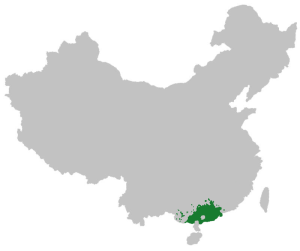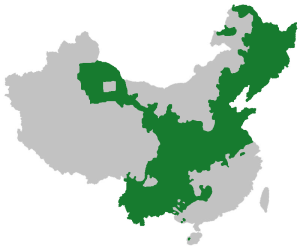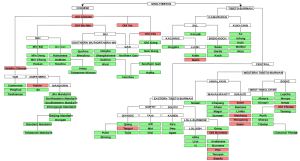- +44 (0)20 8334 8266
- uk@lan-bridge.com
- 中文
What language does China speak?
What language does China speak?
For most people, this might seem like a question with an obvious answer. However, when you look closer at it, the answer isn’t quite so straightforward.
Answer 1: Chinese
This is technically correct. However, it wouldn’t be fatuous in reply in turn, ‘Which Chinese language?’ From a linguistic point of view, this answer is a bit like saying Germany speaks ‘Germanic’, or France speaks ‘Romance’.
Many people, therefore, will probably resort answer 2.
Answer 2: Mandarin (or Cantonese)
These are the two most widely spoken Chinese languages. Most of you will probably already know that Mandarin is spoken in Mainland China whereas Cantonese is spoken in Hong Kong and the nearby southern provinces.
Though they share (most of) a writing system, these are in fact different languages. If you only understand one, you can’t by default understand the other – though you may be able to comprehend the other one in written form.

Picture 1. Where Cantonese is spoken in China.

Picture 2. Where Mandarin is spoken in China.
Mandarin is by far the larger language, with up to approximately 900 million speakers in China. Cantonese is a relatively small language, with 80 million native speakers. However, with large-scale internal migration in China the use of Mandarin is growing rapidly, even in areas once dominated by Cantonese.
At this point, it may seem like the question is settled, then…
Answer 3: Mandarin
…This is more or less correct, but when we look at the original question again, perhaps we should emphasis a different part of it: “What language does China speak?” What exactly do we mean by speak? The following two quotes may help cast some light on that is an important distinction:
- ‘30% of our nation’s population does not speak [Mandarin]’
- ‘Out of the 70% who can speak [Mandarin], only 1 in 10 can speak [Mandarin] articulately and fluently.’
(Source: Chinese Ministry of Education)
So as you can see, the picture isn’t quite as clear as it would first seem. However, despite the above figures, there are some other figures worth taking note of:
- Every year 100 million Children attend primary school in China.
- In the year 2000, 36.2% of the population in China lived in urban environments; in 2015, this number had reached 56.1%

Picture 3. School children in China.
These facts both point towards the same trend: the use of Mandarin is growing at an incredibly fast rate. Firstly, this is because Mandarin is the language of instruction in the education system across China. And secondly, as people move to cities in such large numbers, the use of Mandarin as a common language of communication amongst people from different parts of China (who would previously have spoken a different Chinese language or dialect) grows. Both of these factors also contribute to the ongoing rise in fluency the language is experiencing.
So, now you can see why the first question wasn’t so straightforward after all. But just as you reached this sentence, or perhaps one of the previous few, your noticed from the corner of your eye that there was another sentence in bold below followed by text…
Answer 4: Mostly – and increasingly- Mandarin, but some Cantonese, too.
Again, this is largely accurate but not inarguable. You may have realised that the numbers above don’t add up: if only 70% of China speaks Mandarin (and 10% of those speak it fluently), and 80 million speakers of Cantonese, then what to the other approximately 334 million people speak? (And what how do those nearly 87 million non-fluent speakers of Mandarin get by?!)
Well, this answer brings us back to the first answer: for the most part, they speak Chinese languages or dialects.
As you can see from the diagram below, there are many different Chinese languages groups and dialects.

Picture 4. Sino-Tibetan Languages family tree
China has many of difference languages anddialects. The locals often insist that they are the latter, and designate the word ‘话’ (huà) (‘dialect’ in Mandarin) to distinguish this – as opposed to ‘语’ (yǔ) (‘language’). This of course makes it easier to distinguish domestic and foreign languages, however, to someone unfamiliar with just how different many of these tongues are, it may be misleading. For example, if someone from Beijing who only spoke the Beijing dialect (Běijīng huà) met someone from Shanghai who only spoke Shanghainese (Shànghǎi huà), it would be natural to assume that they can communicate about basic things. However, this would not be the case, as these have totally separate pronunciation, vocabulary, grammar, etc.
The ‘dialect/language’ confusion happens in reverse across the world with many languages that are extremely similar being designated as separate for political reasons (I won’t name any names, here…) Either way, it is true that the boundary between languages and dialects is difficult to set. The old joke goes: “What’s the difference between a language and a dialect? An army.”
Answer 5: Mostly – and increasingly- Mandarin, but also some Cantonese and other Chinese languages, too.
Finally, we have arrived at as accurate an answer as this author sees fit (for now)! Next week, we will look closer at where Mandarin came from, and how long it has been in use.
Follow us on WeChat






